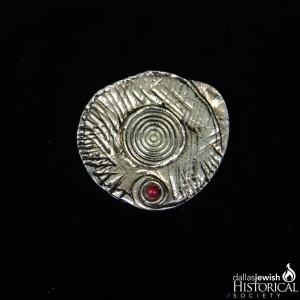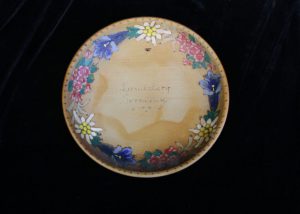by DJHS Archivist | Jul 28, 2020 | From the Archive |
This brooch or pendant, depending on how you wear it, was created in 1977 by the artist Jean David, who was once a member of the Surrealist group “Unu.” He worked with many artistic mediums like ceramics, painting, collage, and wall hangings, while gaining a reputation as a muralist and poster designer thanks to his colorful, florid aesthetic.
The design of this brooch comes in various styles some silver, or gold, some with no stone, some with turquoise or in this case a red stone. But the design of it truly reflects his modern, surrealist, abstract style of work.
From the Ginger Jacobs Collection

See more of his artwork here —-> https://www.invaluable.com/artist/david-jean-1908-zpbosdh752/sold-at-auction-prices/
https://www.ebay.com/itm/Jean-David-Tourist-Trio-Israeli-Jewish-Romanian-Ink-Collage-Modern-Art-/382987771104
https://www.wikiart.org/en/jean-david
by DJHS Archivist | Jul 23, 2020 | From the Archive |
This lucite paperweight contains a commemorative coin of Israel from 1971. One side of the coin shows The Knesset building, and the opposite side shows the city of Jerusalem. Annually, a commemorative coin is released to honor the independence of Israel and highlight an achievement of the nation.
Jakob Zim (1920-2015) was the artist of the coin. Known for his paintings he also designed the symbol of the city of Netanya on the 5000 shekel banknote for the Bank of Israel in 1984. The Knesset building located in Jerusalem, holds the uni-cameral house of representatives for the State of Israel, with 120 members. “The name “Knesset” derives from the “Great Knesset” (“Great Assembly”) which convened in Jerusalem after the return of the Jews to Eretz Yisrael from the Babylonian exile in the fifth century B.C.E” (http://www.knesset.gov.il/history/eng/eng_hist.htm).
https://museum.imj.org.il/artcenter/newsite/en/?artist=Zim,%20Jakob,%20Israeli,%20born%20Poland,%201920-2015
https://en.israelmint.com/default/15046702.html

by DJHS Archivist | Jul 21, 2020 | From the Archive |
Jewelry designer Eytan Brandes from California designed this 2010-2011 (5771) brooch given to donors of the Torah Fund. “Women’s League and Torah Fund are proud to support the education of the future rabbis, cantors, educators, and scholars who will serve as the gifted leaders and innovators of the Conservative Movement.” Since its inception in 1942, the Torah Fund has raised more than 95 million dollars. “The Torah Fund Campaign of Women’s League for Conservative Judaism is the dedicated philanthropy of Women’s League, its members, and its affiliated sisterhoods in Conservative congregations across North America.”
Kehillah Kedoshah: Celebrating Community Woman to Woman: The 5771 Torah Fund Pin commemorates the energizing power of women’s community. Kehillah Kedoshah was the common term for Jewish community in Eastern Europe, but it also implies a community bound together by similar values and beliefs. The images contained within this stylized hamsa* pin reflect women in celebration, dancing and praising. The pin’s golden flame, representing the Women’s League logo, alludes to our members who are committed to a common purpose and the unbreakable bonds of Sisterhood.
From the Ginger Jacobs Collection

http://s3.amazonaws.com/fedweb-assets/103/199/Volume%25203%2520Issue%25201January%25202011.pdf
http://www.jtsa.edu/torah-fund
by DJHS Archivist | Jul 16, 2020 | From the Archive |
Framed photograph of Martha Lubrjanezki Israelski (mother), Ingeborg Israelski Czerner (1926-1993) (left), and probably Manfred Israelski (Brother)(right). Donated by the daughter of Ingeborg, Michelle Czerner, in 2014. Martha Lubrjanezki Israelski passed away at the Theresienstadt concentration camp in Czechoslovakia in 1944. In 1990 Ingeborg Israelski Czerner created an Oral History that is currently at the UNT archives

by DJHS Archivist | Jul 9, 2020 | From the Archive |
Pi Tau Pi Fraternity was founded November 9, 1909 by Fred Wolff, Al V. Levy, Harry Oppenheimer, and R. W. Apte. It was local to St. Louis, Missouri, but became a national co-ed charter. It was created with the intent, “to promote and encourage Judaism; to advance Hebraic culture; to aid in the abolishment of prejudice against the Jew; and to further activities social and philanthropic.”
This host nametag for May Sebel is from the Pi Tau Pi conclave, or alumni meetup, that occurred in Dallas July 4-7, 1962. While it is unclear what activities occurred during the conclave, the theme seemed to be “Do It In Dallas,” as it says on the nametag. The Pi Tau Pi fraternity disbanded in 1967, 5 years after this conclave; however, there are many Jewish fraternities that exist today.
From the May Sebel Collection

https://web.tul-infra.page/finding_aids/pi-tau-pi-fraternity-records
by DJHS Archivist | Jul 7, 2020 | From the Archive |
This wooden bowl with decorative painted flowers looks to be a souvenir from Landsberg Germany. Landsberg is home to the prison which once imprisoned Adolf Hitler after the failed Munich Beer Hall Putsch. He was imprisoned in 1924 and served less than a half a year in the prison. “Hitler also famously used his time of incarceration in Landsberg to write his book, ‘Mein Kampf’ one of the major pieces of propaganda that would push Germans towards the Nazi party.”
Sources indicate, “after WWII the US Army took over and Landsberg Prison became War Criminal Prison No. 1, the main holding cell for captured Nazis. Over a five year period between 1945 and 1950 over 278 Nazi’s were executed at the prison for their crimes against humanity.”
The Kaufering Concentration Camp located in Landsberg was a subcamp of Dachau. It is the only privately owned concentration camp site in Germany. In 2018, the mayor of Landsberg, Mathias Neuner, stated that a permanent historical exhibition was in the works.

Sources:
https://www.atlasobscura.com/places/landsberg-prison-where-hitler-wrote-mein-kampf
https://encyclopedia.ushmm.org/content/en/article/kaufering
https://www.thejc.com/news/news-features/german-town-where-nothing-happened-confronts-nazi-past-landsberg-am-lech-1.468210







Recent Comments